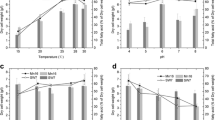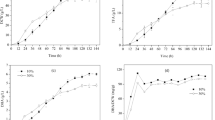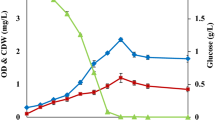Abstract
The marine organism Moritella marina MP-1 produces the polyunsaturated fatty acid docosahexaenoic acid (DHA). While the basic metabolic pathway for DHA production in this organism has been identified, the impact of growth conditions on DHA production is largely unknown. This study examines the effect of supplemental carbon, nitrogen and salts, growth temperature and media composition and pH on DHA and biomass production and the fatty acid profile. The addition of supplemental nitrogen significantly increased the overall DHA titer via an increase in biomass production. Supplemental glucose or glycerol increased biomass production, but decreased the amount of DHA per biomass, resulting in no net change in the DHA titer. Acidification of the baseline media pH to 6.0 increased DHA per biomass. Changes in growth temperature or provision of supplemental sodium or magnesium chloride did not increase DHA titer. This organism was also shown to grow on defined minimal media. For both media types, glycerol enabled more DHA production per biomass than glucose. Combination of these growth findings into marine broth supplemented with glycerol, yeast extract, and tryptone at pH 6.0 resulted in a final titer of 82 ± 5 mg/L, a nearly eightfold increase relative to the titer of 11 ± 1 mg/L seen in the unsupplemented marine broth. The relative distribution of other fatty acids was relatively robust to growth condition, but the presence of glycerol resulted in a significant increase in myristic acid (C14:0) and decrease in palmitic acid (C16:0). In summary, DHA production by M. marina MP-1 can be increased more than fivefold by changing the growth media. Metabolic engineering of this organism to increase the amount of DHA produced per biomass could result in additional increases in titer.



Similar content being viewed by others
References
Alder J, Watson R (2007) Fisheries globalization: fair trade or piracy? In: Taylor WW, Schechter MG, Wolfson LG (eds) Globalization: effects on fisheries resources. Cambridge University Press, New York, pp 47–74
Bligh EG, Dyer WJ (1959) A rapid method of total lipid extraction and purification. Can J Biochem Physiol 37(8):911–917
Busch B, Hertweck C (2009) Evolution of metabolic diversity in polyketide-derived pyrones: using the non-colinear aureothin assembly line as a model system. Phytochem 70(15–16):1833–1840. doi:10.1016/j.phytochem.2009.05.022
Calderone CT (2008) Isoprenoid-like alkylations in polyketide biosynthesis. Nat Prod Rep 25(5):845–853. doi:10.1039/b807243d
Campbell CD, Vederas JC (2012) Biosynthesis of lovastatin and related metabolites formed by fungal iterative PKS enzymes. Biopolym 93(9):755–763. doi:10.1002/bip.21428
Chapkin RS, Seo JM, McMurray DN, Lupton JR (2008) Mechanisms by which docosahexaenoic acid and related fatty acids reduce colon cancer risk and inflammatory disorders of the intestine. Chem Phys Lipids 153(1):14–23. doi:10.1016/j.chemphyslip.2008.02.011
Connor SL, Zhu N, Anderson GJ, Hamill D, Jaffe E, Carlson J, Connor WE (2000) Cheek cell phospholipids in human infants: a marker of docosahexaenoic and arachidonic acids in the diet, plasma, and red blood cells. Am J Clin Nutr 71(1):21–27
Delong EF, Yayanos AA (1986) Biochemical function and ecological significance of novel bacterial lipids in deep-sea prokaryotes. Appl Environ Microbiol 51(4):730–737
Hites RA, Foran JA, Carpenter DO, Hamilton MC, Knuth BA, Schwager SJ (2004) Global assessment of organic contaminants in farmed salmon. Science 303(5655):226–229
Hur Byung-Ki CD-W, Kim H-J, Park C-I, Suh H-J (2002) Effect of culture conditions on growth and production of docosahexaenoic acid (DHA) using Thraustochytrium aureum ATCC 34304. Biotechnol Bioprocess Eng 7(1):6
Jenke-Kodama H, Sandmann A, Muller R, Dittmann E (2005) Evolutionary implications of bacterial polyketide synthases. Mol Biol Evol 22(10):2027–2039. doi:10.1093/molbev/msi193
Jenkins DJA, Sievenpiper JL, Pauly D, Sumaila UR, Kendall CWC, Mowat FM (2009) Are dietary recommendations for the use of fish oils sustainable? Can Med Assoc J 180(6):633–637. doi:10.1503/cmaj.081274
Jeong YS, Song SK, Lee SJ, Hur BK (2006) The growth and EPA synthesis of Shewanella oneidensis MR-1 and expectation of EPA biosynthetic pathway. Biotechnol Bioprocess Eng 11(2):127–133
Kautharapu KB, Jarboe L (2012) Genome sequence of psychrophilic deep sea bacterium Moritella marina MP-1. J Bacteriol 194:6296–6297
Kramer JK, Fellner V, Dugan ME, Sauer FD, Mossoba MM, Yurawecz MP (1997) Evaluating acid and base catalysts in the methylation of milk and rumen fatty acids with special emphasis on conjugated dienes and total trans fatty acids. Lipids 32(11):1219–1228
Lagarde M (2008) Docosahexaenoic acid: nutrient and precursor of bioactive lipids. Eur J Lipid Sci Technol 110(8):673–678. doi:10.1002/ejlt.200800087
Lee SJ, Jeong YS, Kim DU, Se JW, Hur BK (2006) Eicosapentaenoic acid (EPA) biosynthetic gene cluster of Shewanella oneidensis MR-1: cloning, heterologous expression, and effects of temperature and glucose on the production of EPA in Escherichia coli. Biotechnol Bioprocess Eng 11(6):510–515
Li JJ, Huang CJ, Xie D (2008) Anti-obesity effects of conjugated linoleic acid, docosahexaenoic acid, and eicosapentaenoic acid. Mol Nutr Food Res 52(6):631–645. doi:10.1002/mnfr.200700399
Metz JG, Roessler P, Facciotti D, Levering C, Dittrich F, Lassner M, Valentine R, Lardizabal K, Domergue F, Yamada A, Yazawa K, Knauf V, Browse J (2001) Production of polyunsaturated fatty acids by polyketide synthases in both prokaryotes and eukaryotes. Science 293(5528):290–293
Morita N, Ichise N, Yumoto I, Yano Y, Ohgiya S, Okuyama H (2005a) Cultivation of microorganisms in the cultural medium made from squid internal organs and accumulation of polyunsaturated fatty acids in the cells. Biotechnol Lett 27(13):933–941. doi:10.1007/s10529-005-7187-3
Morita N, Nishida T, Tanaka M, Yano Y, Okuyama H (2005b) Enhancement of polyunsaturated fatty acid production by cerulenin treatment in polyunsaturated fatty acid-producing bacteria. Biotechnol Lett 27(6):389–393. doi:10.1007/s10529-005-1532-4
Nagano N, Taoka Y, Honda D, Hayashi M (2009) Optimization of culture conditions for growth and docosahexaenoic acid production by a marine thraustochytrid, Aurantiochytrium limacinum mh0186. J Oleo Sci 58(12):623–628
Napier JA (2002) Plumbing the depths of PUFA biosynthesis: a novel polyketide synthase-like pathway from marine organisms. Trends Plant Sci 7(2):51–54
Nishida C, Uauy R, Kumanyika S, Shetty P (2004) The joint WHO/FAO expert consultation on diet, nutrition and the prevention of chronic diseases: process, product and policy implications. Public Health Nutr 7(1A):245–250. doi:10.1079/PHN2003592
Nishida T, Hori R, Morita N, Okuyama H (2010) Membrane eicosapentaenoic acid is involved in the hydrophobicity of bacterial cells and affects the entry of hydrophilic and hydrophobic compounds. FEMS Microbiol Lett 306:91–96. doi:10.111/j.1574-6968.2010.01943x
Shen B (2003) Polyketide biosynthesis beyond the type I, II and III polyketide synthase paradigms. Curr Opin Chem Biol 7(2):285–295. doi:10.1016/s1367-5931(03)00020-6
Siddiqui RA, Harvey K, Stillwell W (2008) Anticancer properties of oxidation products of docosahexaenoic acid. Chem Phys Lipids 153(1):47–56. doi:10.1016/j.chemphyslip.2008.02.009
Stevens PJC, Baker EA, Anderson NH (1988) Factors affecting the foliar absorption and redistribution of pesticides. 2. Physicochemical properties of the active ingredient and the role of the surfactant. Pestic Sci 24(1):31–53
Usui K, Hiraki T, Kawamoto J, Kurihara T, Nogi Y, Kato C, Abe F (2012) Eicosapentaenoic acid plays a role in stabilizing dynamic membrane structure in the deep-sea piezophile Shewanella violacea: a study employing high-pressure time-resolved fluorescence anisotropy measurement. Biochim Biophys Acta 1818:574–583. doi:10.1016/j.bbamem.2011.10.010
Valenzuela A (2009) Docosahexaenoic acid (DHA), an essential fatty acid for the proper functioning of neuronal cells: their role in mood disorders. Grasas Y Aceites 60(2):203–212. doi:10.3989/gya.085208
Wall R, Ross RP, Fitzgerald GF, Stanton C (2010) Fatty acids from fish: the anti-inflammatory potential of long-chain omega-3 fatty acids. Nutr Rev 68(5):280–289. doi:10.1111/j.1753-4887.2010.00287.x
Wang F, Xiao X, Ou HY, Gai YB, Wang FP (2009) Role and regulation of fatty acid biosynthesis in the response of Shewanella piezotolerans WP3 to different temperatures and pressures. J Bacteriol 191(8):2574–2584. doi:10.1128/jb.00498-08
Wanner BL (1994) Gene expression in bacteria using TnphoA and TnphoA’ elements to make and switch phoA gene, lacZ (op) and lacZ (pr) fusions. In: Adolph KW (ed) Methods Mol Genet. vol 3. Academic, Orlando, pp 291–310
Wolosin JM, Ginsburg H, Lieb WR, Stein WD (1978) Diffusion within egg lecithin bilayers resembles that within soft polymers. J Gen Physiol 71(1):92–100
Yang Ge LY, Gao M (2011) Effects of pH and aeration on the production of docosahexaenoic acid by Thraustochytrium Aureum in controlled batch fermentor cultures. Adv Mater Res 5:183–185. doi:10.4028/www.scientific.net/AMR.183-185.50
Acknowledgments
This work was supported by Metabolic Technologies, Inc and the Iowa State University Office of Biotechnology. We also gratefully acknowledge Austin Cocciolone, Maria Wahl, Yiqi Sun, and Lee Yeo for their experimental contributions.
Author information
Authors and Affiliations
Corresponding author
Rights and permissions
About this article
Cite this article
Kautharapu, K.B., Rathmacher, J. & Jarboe, L.R. Growth condition optimization for docosahexaenoic acid (DHA) production by Moritella marina MP-1. Appl Microbiol Biotechnol 97, 2859–2866 (2013). https://doi.org/10.1007/s00253-012-4529-7
Received:
Revised:
Accepted:
Published:
Issue Date:
DOI: https://doi.org/10.1007/s00253-012-4529-7




